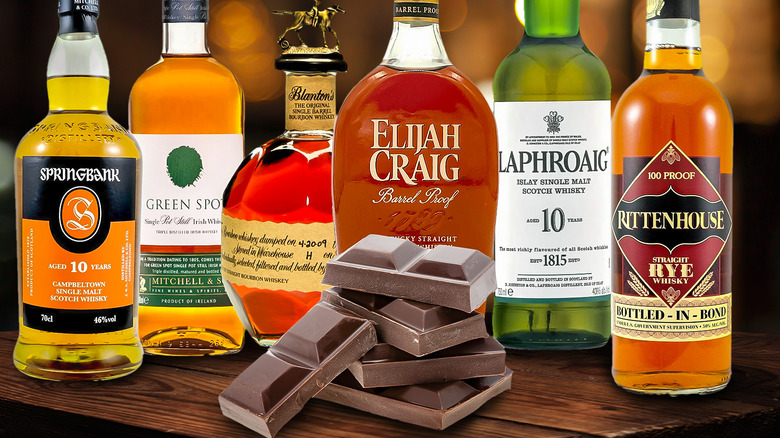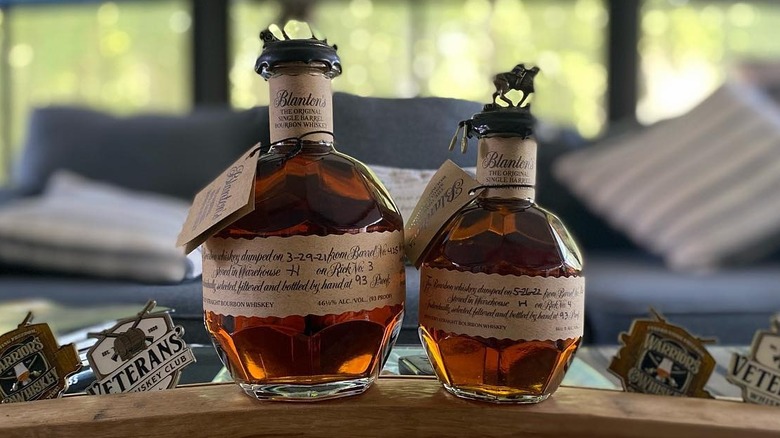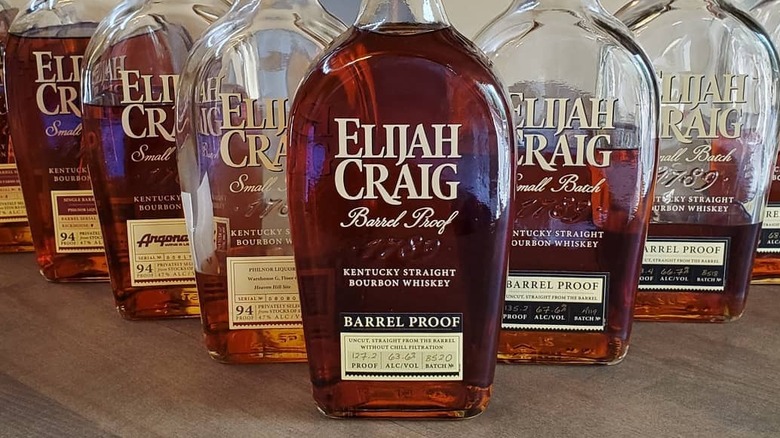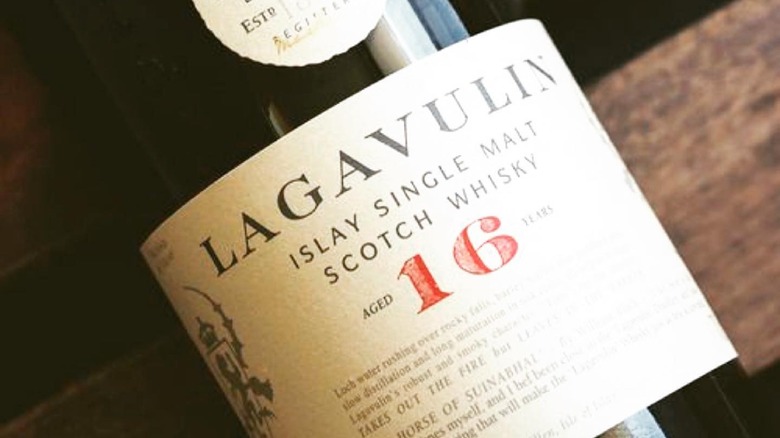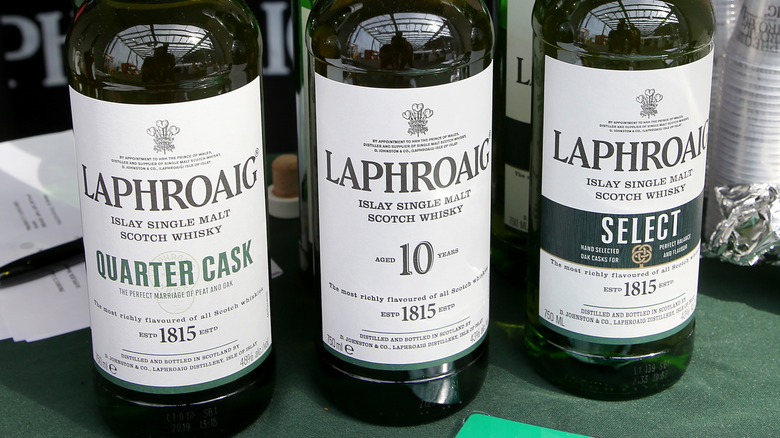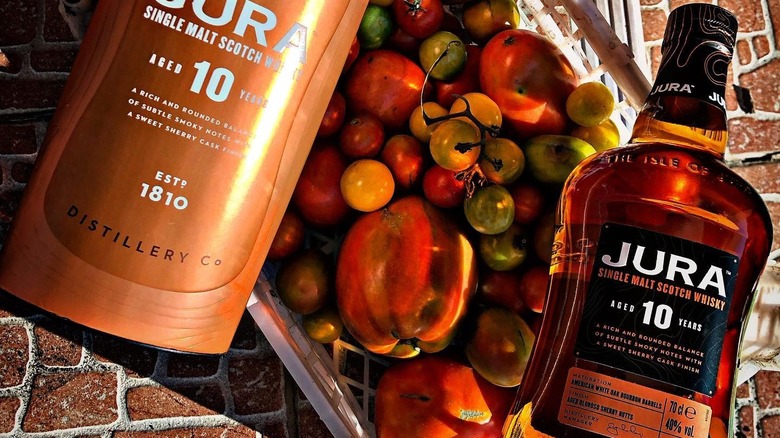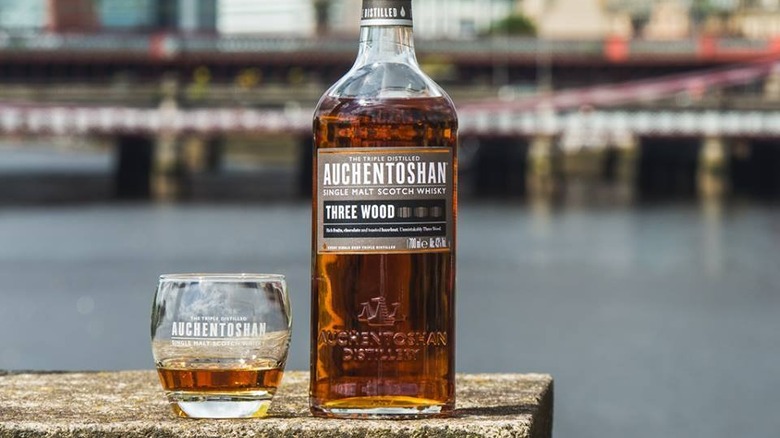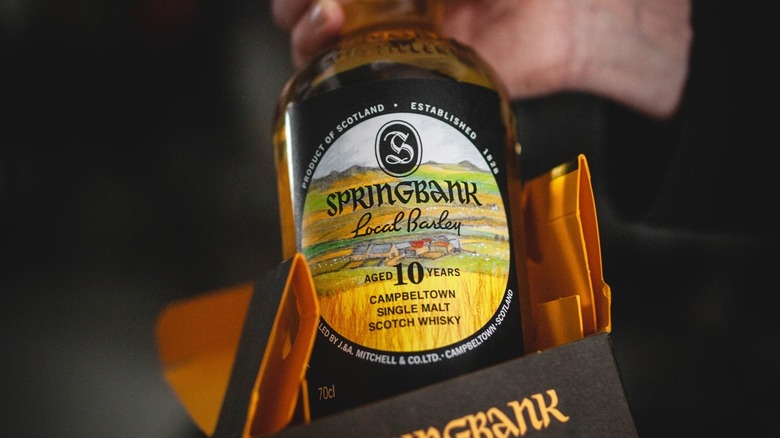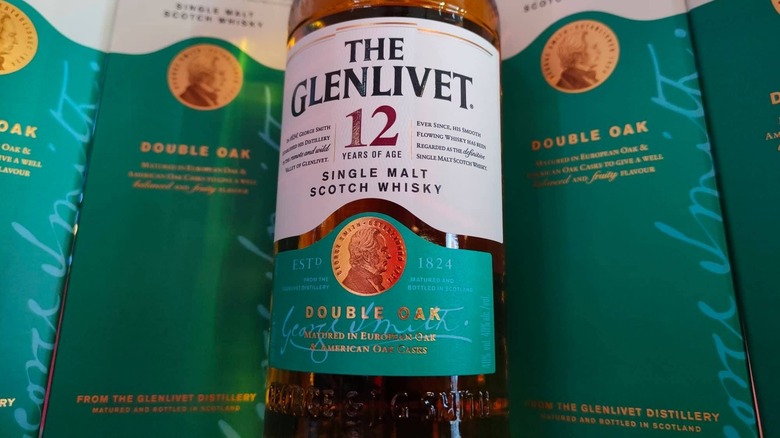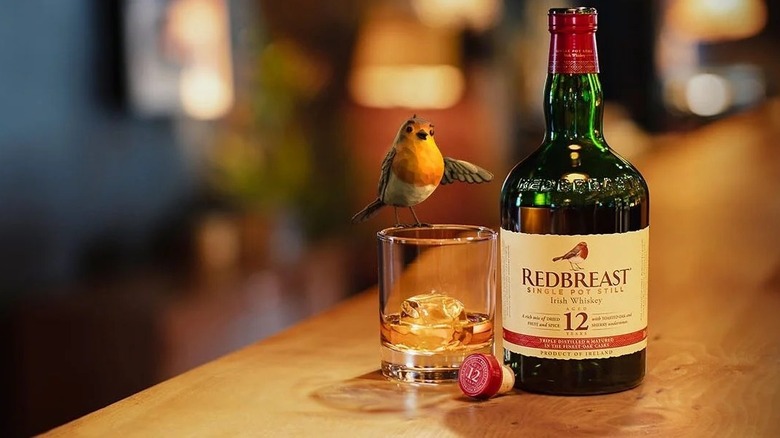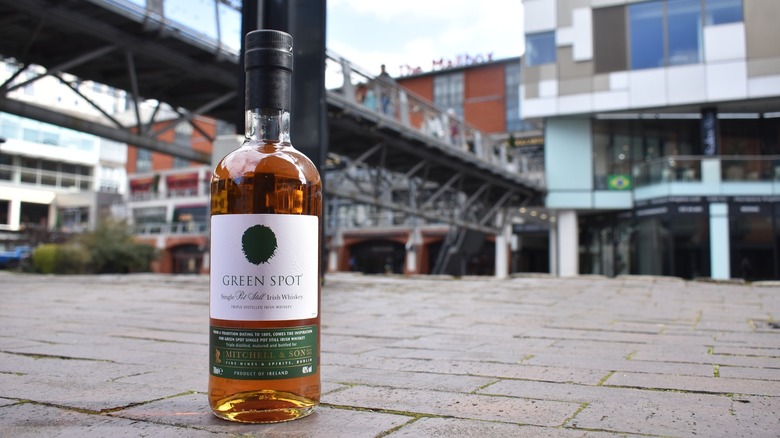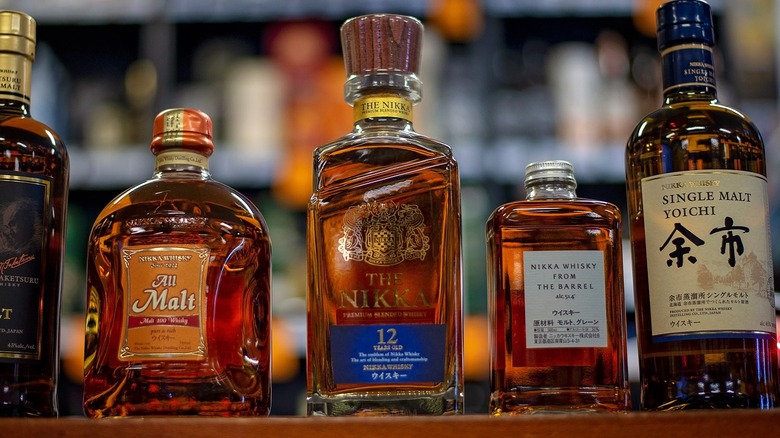12 Whiskeys To Pair With Chocolate
One of the world's most beloved alcoholic beverages, with a name that quite literally used to mean "water of life," whiskey is a spirit that can have limitless expressions based on how and where it was produced. Scotland, Ireland, Japan, and the United States. are all famous for their distinct styles with unique histories, but whiskey's nuances can sometimes make it difficult to pair with chocolate without some preparation.
In case you haven't tried the combination yet, a square of chocolate can be the perfect partner to the right dram, but it can also completely unbalance a whiskey's taste if not chosen properly. A whiskey that's too bold will overpower lighter chocolates, while an intense chocolate can have the same effect on a more delicate whiskey. Depending on the whiskey, you can also have a multitude of characteristics that need to be considered — fruit, spice, nuts, oak, smoke, peat, and even seaweed might be notes you need to factor into your chocolate choice. To help ease you into the art of whiskey and chocolate pairing, we've chosen twelve diverse whiskeys from across the globe that not only taste incredible on their own, but match perfectly with specific types of chocolate.
Blanton's Original Single Barrel
Bourbon is one of the easiest whiskeys to pair with chocolate because it already has a notably sweet flavor profile compared to other styles. There are highly regulated production criteria that a whiskey needs to meet to be called a bourbon, two of which play a huge part in creating the spirit's unique aroma and taste. First, bourbon has to use corn for at least 51% of its mash bill, a grain that produces a sweeter whiskey compared to rye or barley, with notes of creamy brown butter. Bourbon also has to be aged in new, charred oak barrels, which imparts vanilla and caramel flavors into the spirit. It's a common misconception that bourbon has to be produced in Kentucky due to the state's long association with the whiskey, but technically it's still considered bourbon as long as it's made in the United States. However, it should go without saying that not all bourbons taste the same.
Blanton's Original Single Barrel has an excellent reputation — it's sweet, even for a bourbon, but it's fantastically smooth and balanced. The rye in the mash bill adds elements of baking spices, like nutmeg, and on the palate, you'll experience touches of honey and citrus that stand out among the oak, caramel, and vanilla. If you have a sweet tooth, Blanton's dessert-like qualities will boost the creaminess of rich milk chocolate, but some whiskey drinkers prefer more balanced flavors. Picking dark chocolate will offset Blanton's sweetness, but if you're after something truly special, go for one with pieces of real salted caramel to contrast the vanilla and honey.
Elijah Craig Barrel Proof
Compared to the sweet, approachable Blanton's, Elijah Craig Barrel Proof is a force to be reckoned with. Before whiskey is bottled, it's normally diluted to lower the alcohol content and make it more palatable, but if it's labeled as "barrel proof," it's been bottled at the same strength it came out of the cask.
This means Elijah Craig Barrel Proof has an alcohol-by-volume (ABV) of 66.5%, so it might not be the best choice for someone not used to drinking neat spirits. Fortunately, the quality of Elijah Craig whiskey means its higher alcohol content works in its favor, offering a bold nose of butterscotch and charred oak. The rye in the mash bill is also more pronounced, adding aromas of orange and apple, and touches of dried fruit, cinnamon spice, and pepper on the palate.
Something to remember when pairing alcohol with food is that fattier foods give our mouth and tongue a lipid coating. This coating works like a barrier, making higher-fat foods ideal for tempering drinks with intense flavors, like high-proof whiskey or acidic wines. Generally, white and dark chocolates have the highest fat content; however, white chocolate will likely get overpowered by this particular bourbon. Go for rich and dark, but pick a chocolate with dried orange or berries that will complement Elijah Craig's fruity and spicy elements.
Rittenhouse Rye
As we've mentioned, rye in whiskey adds more spice and dried fruit flavors to the final product. Plenty of bourbons add rye to their mash bill for these characteristics, but the corn is always dominant. However, an American rye whiskey legally needs to use at least 51% rye in the mash, so while these whiskeys can still be balanced and delicious, they tend to be drier and more peppery. The malt character also begins to lean away from sweet corn and light caramel, and towards amber toffee or burnt brown sugar.
There are plenty of superb American ryes to choose from, but Rittenhouse ticks a lot of boxes. Aside from being astonishingly good value for money, it's a classic style that's rich and complex enough to enjoy neat, yet versatile enough to work in any number of cocktails like a Sazerac or Manhattan. These qualities make it ideal for pairing with chocolate.
Dark chocolate will temper the 50% ABV thanks to the higher fat content, and one with a touch of chili can enhance the rye's warming flavor profile. In fact, if you want to get creative, try adding a splash to a mug of xocolatl. Rittenhouse's pairs perfectly with spicy hot cocoa drinks, and adding a pinch of salt will reduce the perceived bitterness from the extra dark, Aztec-style chocolate.
Lagavulin 16 Year Old
Moving across the Atlantic, it's time to take a look at scotch whisky, one of the oldest and most diverse styles in the world. While American whiskeys use corn, rye, and wheat in their mash, scotch whiskies primarily use barley, and single malt scotches can solely use malted barley. However, despite using a single type of grain, scotches vary hugely in their flavor profiles. While there are exceptions to the rule, most scotch styles are distinct to one of six regions: Islay, Islands, Highlands, Lowlands, Campbeltown, and Speyside. Lagavulin 16 Year Old is one of the most classic expressions of powerful Islay single-malt, and it can pair fantastically with chocolate.
Islay — an island off the southwest coast of mainland Scotland — has a reputation for malting their barley with burning peat, a type of bog moss, resulting in intensely smoky, earthy whiskies. The maritime climate also plays a part, imparting Islay scotches with hints of oil, seaweed, and salty sea air. Lagavulin 16 Year Old is a peat bomb that embodies these characteristics in abundance, with layers of brine and campfire smoke that give way to dried fruit. To balance these flavors, pick chocolate with sweet, but powerful, ingredients like burnt toffee or caramel, or try pairing it with soft truffles to take the heat out of Lagavulin's lengthy and intense aftertaste.
Laphroaig 10 Year Old
While Laphroaig 10 Year Old also hails from Islay, sharing many of the peaty and maritime notes as Lagavulin, there are a few things that set it apart. Laphroaig is even peatier and smokier than Lagavulin, so if you're new to scotch, you might struggle to pick out its nuances the first time around. It also has an iodine-like flavor that most describe as "medicinal," which can taste more appealing than it sounds, as it's balanced with creamy vanilla, salty seaweed, and peppery spice. Despite a bold, dry finish, Laphroaig isn't without a touch of sweetness, and it can still be paired with chocolate if you choose wisely.
To stand up to the intense peat smoke, you'll want to pair Laphroaig 10 Year Old with a great-quality, high-cocoa, dark chocolate — don't worry about the chocolate being too dark, as the sea salt of the whisky will temper the bitterness. However, the challenge with Laphroaig is matching its medicinal taste, which is where mint-flavored chocolate will complement that particularly unique quality.
Jura 10 Year Old
Jura whisky shares its name with the island it comes from adjacent and northeast of Islay. Although Islay is considered its own whisky-producing region, other island-made scotches are simply considered to be from the "Island" region. Like Islay whiskies, Island whiskies share some coastal characteristics, like an oily mouthfeel and touches of salinity, and the region's producers are no strangers to peat either. Island whiskies can vary widely in their style — Scotland has no shortage of islands after all — and the Jura 10 Year Old single malt is considerably more approachable than its Islay cousins.
The peat and spice is present in Jura 10 Year Old but it's far more subtle, allowing green fruit flavors like apple and pear to come forward, alongside raisin and vanilla. As a result, you don't have to pair it with darker chocolates to avoid flavors being lost, and even white chocolate should let Jura's flavors shine though. However, the whisky's fruit notes do benefit from being matched with nutty varieties, especially hazelnut. If nuts aren't your thing, the citrus element from orange chocolate — or chocolate truffles filled with orange creme — can also make the apple and pear notes more pronounced.
Auchentoshan Three Wood
The Lowland scotch-making region was once packed with distilleries, but, over time, a number of factors caused production to fall dramatically. Fortunately, distilleries like Auchentoshan — who have been around since 1823 — weathered the sector's downturn and lived on to produce whisky in the classic Lowland style.
Typically, Lowland single-malts have a nuttier, grassier profile because distillers in the region historically triple-distilled their whisky. Triple-distillation is a process that's most commonly associated with Irish whiskey, whereas the vast majority of scotch is double-distilled. Distilling the whisky three times increases the alcohol content, but it also filters out heavier flavor components, resulting in a lighter, floral taste. Over the years, Auchentoshan has continued to triple distill their whisky, but their Three Wood expression adds extra layers of complexity by aging the spirit in American bourbon barrels, followed by two different types of sherry cask. The outcome is plenty of dark fruits, like plum and blackcurrant, on the nose, butterscotch, sherry, and hazelnut on the tongue, and a fresh, oaky finish.
To contrast Auchentoshan Three Wood's sweeter notes from the sherry casks, it's best to pick a darker chocolate. If you want to make the most of the whisky's complexity, try pairing it with dark chocolate-coated almonds that enhance the fruit and nut flavors, while adding a touch of salt to the palate.
Springbank 10 Year Old
Like the Lowland region, Campbeltown distilleries also faced challenges in their history that heavily reduced the number of producers in the area. Founded back in 1828, the Springbank Distillery is now one of only three that still exist in the region. If you look at the Campbeltown region on a map, you'll notice it's a coastal town and seaport, so we can expect its single malts to have similar qualities to Islay and Island whiskies: an oily texture with notes of seaweed and salt. However, whiskies like Springbank 10 Year Old tend to be much lighter on the peat and smoke, which allows honeycomb and toffee to burst through, alongside touches of fruit and baking spice, before a briny finish.
Springbank 10 Year Old might not be as intense as Lagavulin or Laphroaig in terms of overpowering elements, but it still packs plenty of complex flavors and a sweetness from being aged in bourbon and sherry casks. It's best to keep things simple here — opt for a high-quality bar of creamy milk chocolate and let the whisky do the heavy lifting.
Glenlivet 12 Year Old
Speyside is home to more distilleries than any of the other whisky-producing regions; consequently, you'll find a lot of variety among their scotches, from light and grassy to rich and sweet. Generally, Speyside single malts have a pronounced yet refined smoky quality, with notes of honey, green fruit, and delicate nutmeg and cinnamon spice. Glenlivet 12 Year Old exemplifies the best qualities of a classic Speyside whisky. Despite its complexity, it's smooth and accessible, while the gentle smoke makes it an appropriate stepping stone to the more potent Islay and Island drams.
At 40% ABV and with a lighter profile, you can match white, milk, or dark chocolate with Glenlivet 12 Year Old easily, as you don't have to worry about tempering alcohol or pronounced flavors. Fruity chocolates are an excellent pairing choice, with orange citrus or dark berries complementing the palate. If you prefer savory flavors, you can also give floral or herbaceous chocolates a try, particularly lavender or rosemary varieties.
Redbreast 12 Year Old
While it's impossible to pin down the precise origins of whiskey, the earliest written evidence points toward the Irish, and we know they were the first to start exporting it globally. However, despite a shared Celtic heritage and close geographic proximity, there are noticeable differences between Irish whiskey and scotch. The main difference is that Irish whiskeys are triple rather than double-distilled. This means they're usually smoother with more orchard fruit notes, like peach, pear, and apple. Additionally, while single malt scotch has to be made with 100% malted barley, Irish whiskeys are allowed more diversity in their malt bill. A single pot still Irish whiskey, Redbreast adds unmalted barley along with the malted grains.
The original reasoning for this was to avoid an 18th-century tax the British Crown had implemented on malted barley, but the style stuck around. The unmalted grain alters the flavor profile of Irish whiskey, adding elements of spice and citrus, and forming a creamier mouthfeel.Redbreast 12 Year Old uses a 50/50 split of malted and unmalted barley from a single still, making it a rich and complex expression of Irish whiskey. Its flavor is almost like Christmas cake, with notes of baking spices, nuts, and dried fruit. Redbreast also has a balanced sweetness thanks to maturation in both bourbon and sherry casks, so a darker chocolate with candied ginger is the ultimate pairing with Redbreast's festive flavorings.
Green Spot Single Pot Still
By comparing Green Spot to Redbreast, you can see just how much Irish whiskeys can vary in taste, especially considering both are single pot still whiskeys. While Redbreast is far more robust, Green Spot presents a lighter, fruitier spice profile with notes of smooth vanilla, sweet apple, crisp pear, and cinnamon. Green Spot tends to use slightly more unmalted barley in their malt bill, which adds to the spice, but the whiskey is also aged for less time than Redbreast, so it's ultimately not as rich and lacks some of the flavors imparted by the barrel.
Green Spot is also aged in bourbon and sherry casks, but features more of bourbon's characteristics than Redbreast. Green Spot's lower complexity means it pairs well with either milk or dark chocolate, and ginger still works well with its flavor profile. However, caramel, orange, or hazelnut chocolates will also complement the whiskey's fruity spiciness.
Nikka 12 Year Old
Although once overlooked by whiskey connoisseurs, Japanese whisky has become one of the most sought-after varieties in recent years, leading to both a shortage of supply, and an increase in price. Nikka is one of the most highly-regarded names in the Japanese whisky business, and their The Nikka 12 Year Old is a superb expression of the Japanese whisky style. Japanese whisky-making is unapologetically influenced by Scottish distillers, so they share many characteristics, with the notable exception of heavy peat. The Nikka's Scottish influence is noticeable in its complexity, and a balance of flavors including apple, pear, and plum, and hints of oak.
The sweeter profile of The Nikka means it can pair fantastically with a bar of creamy milk chocolate that complements the soft orchard fruit elements, but there's a more interesting and flavorful option available. Sticking with the theme of Japanese cuisine, a matcha green tea-flavored white chocolate introduces a unique, bittersweet grassiness into the mix, plus it adds a touch of umami that's balanced out by the extra sweetness of the chocolate style.
